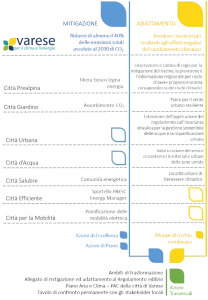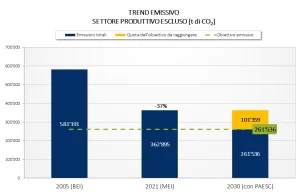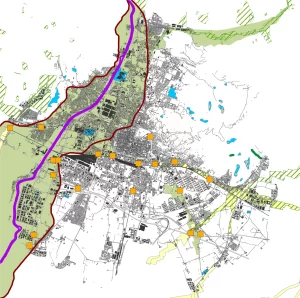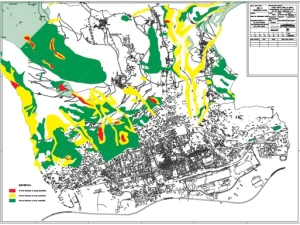Sustainable Energy and Climate Action Plans
TerrAria has supported more than 300 public administrations in the preparation of Sustainable Energy and Climate Action Plans (SECAP) including Bergamo, Brescia, Aosta and Varese, and previously, more than 100 administrations in the drafting of Sustainable Energy Action Plans (SEAP), with a view to reducing CO2 , energy efficiency and defining concrete actions to achieve the targets set by the EU.
Sustainable Energy and Climate Action Plans (SECAP) and Sustainable Energy Action Plans (SEAP) are strategic tools used by municipalities to reduce CO2 emissions and address climate change. The SEAP focuses primarily on implementing measures to improve energy efficiency and increase the use of renewable energy sources. The SECAP expands this approach to include actions to adapt to climate change. Both plans represent concrete commitments made by local governments under the Covenant of Mayors aimed at achieving energy and environmental sustainability goals.
In this activity, TerrAria made available to PAs the CO20 software, which we developed specifically to support signatories of the Covenant of Mayors.
BERGAMO
The City Council of the City of Bergamo approved the Sustainable Energy and Climate Action Plan (SECAP) on March 4, 2024, committing to reduce at least 55% of CO2 emissions by 2030.
The Bergamo Municipal Administration had joined the Covenant of Mayors in December 2009 by conducting 3 Monitoring Reports, 2 of which were prepared by the TerrAria srl team. With the last monitoring of the SEAP “Final Report,” prepared in 2021, the emission reduction target of 20% had been met and exceeded.
In November 2021, the mayor renewed his adherence to the Covenant of Mayors, pledging to shift his reduction target to at least 55% CO2 by 2030 and to aspire to decarbonize the municipality by 2050.
The Mitigation Plan, as anticipated, calls for a 55 percent reduction in the CO2 emissions recorded in Bergamo in 2005. The emission inventory to 2021 already sees a 37% reduction in emissions compared to 2005 (the first reference year for the SECAP). The main areas of action that the Action Plan focuses on are:
- the municipal tertiary sector specifically municipal buildings, for which efficiency upgrading is being carried out through an EPC (Energy Performance Contract) contract;
- the residential sector, for which work is planned to modernize technological systems related to lighting and an upgrade of obsolete boilers in addition to interventions related to energy savings on the building envelope;
- the non-municipal tertiary sector for which thermal and electrical consumption is expected to be reduced through energy-saving actions.
Another important area of intervention is public lighting for which the replacement of obsolete elements with LED technology is planned to be completed. For the sector of sustainable mobility, within the Mitigation Plan, in line with the Urban Sustainable Mobility Plan, the aim is to raise awareness of the use of soft mobility among the population through the creation of bicycle paths, pedestrian areas and adherence to the Pedibus service. As a result of the actions in the Plan, the goal of reducing CO2 , or 101’350 tons, by 55 percent by 2030 is expected to be met and exceeded. In addition to the reduction of CO2 emissions, thanks to the PAESC it is expected to increase the use of energy from renewable sources and a reduction in energy consumption.
Among the strategic actions introduced by the SECAP we find the development of Renewable Energy Communities (RECs), in particular, the SECAP envisages the creation of a public CER REC (Feasibility Study submitted to the Lombardy Region Call for Proposals was prepared by TerrAria) that can be a tool to combat energy poverty.
The Adaptation Plan, on the other hand, was based on Bergamo’s Cli.c. Climate Transition StrategyBergamo’s Cli.c. Climate Transition Strategy, which, with a non-repayable Funding from Fondazione Cariplo and Regione LombardiaLombardy Region of € 2’400’000, identified 7 types of areas of intervention in which to decline no. 19 actions.
Emission trend of the City of Bergamo (source: our processing).
BRESCIA
The City of Brescia approved the Covenant of Mayors for Energy and Climate (SECAP) on 5/24/2021. The SECAP includes two central and one cross-cutting elements of energy efficiency and increased use of renewable energy sources:
- mitigation (an objective already present in the SECAP) – the reduction of CO2 (decarbonization of territories);
- adaptation (a new goal of the SECAP) – the reduction of climate change risks
The SECAP document consists of three sections: the municipal inventory of energy consumption and CO2 (BEI – Baseline Emission Inventory), including a picture of the risks and vulnerabilities to which the municipality is subject, the Decarbonization Action Plan, and the Adaptation Action Plan.
For the City of Brescia, the 2030 emissions reduction target was calculated with BEI as of 2010, excluding emissions from the production sector in per capita terms: through the actions of the Brescia SECAP, a per capita emissions reduction target of 50% can in fact be achieved and exceeded. Specifically, an increase in emissions of about 25’072 tons was estimated and it was assumed that by 2030 total emissions would be about 646’371 tons (productive sector excluded), assuming that emissions related to the existing stock remain the same as at BEI: the emission reduction to be achieved by 2030 was thus estimated at about 312’400 tons.
The section on climate adaptation, in synergy with the Climate Transition Strategy (STCCTS) identified the main environmental hazards related to climate change and the resulting risks. From the situation analysis, specific actions were identified.
Risks and vulnerabilities in the City of Brescia (source: our processing).
AOSTA
The Municipality of Aosta resolved to sign up to the Covenant of Mayors for Energy and Climate (SECAP) with City Council Resolution No. 92 of 10/23/2019 committing to prepare the SECAP to achieve the goal of:
- Reduction of at least 40 percent of CO2 emissions to 2030 compared with the emission inventory at the base year (Baseline) particularly through improved energy efficiency and increased use of renewable energy sources;
- Increase their resilience by adapting to the effects of climate change;
- pool their vision, achievements, experience and know-how with other local and regional authorities in the EU and beyond through direct cooperation and peer-to-peer exchange, particularly under the Global Covenant of Mayors.
The SECAP document consists of three-part sections: the municipal inventory of energy consumption and CO2 (BEI – Baseline Emission Inventory), including a picture of the risks and vulnerabilities to which the municipality is subject, the Decarbonization Action Plan, and the Adaptation Action Plan.
For the Municipality of Aosta, the emission reduction target to 2030 was calculated with BEI to 2018, the decision fell on 40% absolute emission reduction excluding the production sector. Specifically, the estimated emission reduction to be achieved by 2030 is 31,291 tons of CO2 .
The section on climate adaptation defines the framework of municipal risks and vulnerabilities from documents such as the Municipal Civil Protection Plan, Municipal Regulatory Plan, Regional Forest Fire Plan, data released by Arpa Valle d’Aosta, and the Report on Climate Change in VdA.
Landslide areas in the Municipality of Aosta (Source: Civil Protection Plan).
Taking their cue from the vulnerabilities and risks identified for the Aosta territory, specific actions of direct and indirect competence have been identified, i.e., also including the actions of direction, influence, awareness-raising that the Administration itself can exercise.
VARESE
The City of Varese approved the Covenant of Mayors for Energy and Climate (SECAP) on 07/31/2021. The SECAP includes two central and one cross-cutting elements of energy efficiency and increased use of renewable energy sources:
- mitigation (an objective already present in the SECAP) – the reduction of CO2 (decarbonization of territories);
- adaptation (a new goal of the SECAP) – the reduction of climate change risks
The SECAP document consists of three partthree-part sections: the municipal inventory of energy consumption and CO2 (BEI – Baseline Emission Inventory), including a picture of the risks and vulnerabilities to which the municipality is subject, the Decarbonization Action Plan, and the Adaptation Action Plan.
Having analyzed the context of consumption and emissions, the goal of the Varese PAESC SECAP that was determined by including the production sector and in absolute terms predicting a 40% reduction in absolute emissions present in 2017 by 2030, a reduction corresponding to about 164,398 tons of CO2 .
The analysis of the situation of the Municipality of Varese for the aspect of climate adaptation was conducted through the analysis of materials made available by the CA from which emerged a risk analysis defined as objective and through several moments of discussion with experts and citizens from which emerged a risk analysis defined as subjective. Once the two risk analyses and the sensitivities identified in the area were compared, the climate risks to which the Municipality of Varese is subjected were identified.
On the basis of the territorial analysis carried out in which the distinctive aspects of the municipal territory were addressed with reference to the areas of mitigation and adaptation and the analysis of risk and vulnerability, seven key-dimensions were identified for the City of Varese, to each of which corresponds a characterizing profile of the city: the Pre-Alpine City, the Garden City, the Urban City, the Water City, the Healthy City, the Efficient City, and the Mobility City. Specific and characterizing mitigation and, where possible, adaptation actions have been identified for the different profiles.





